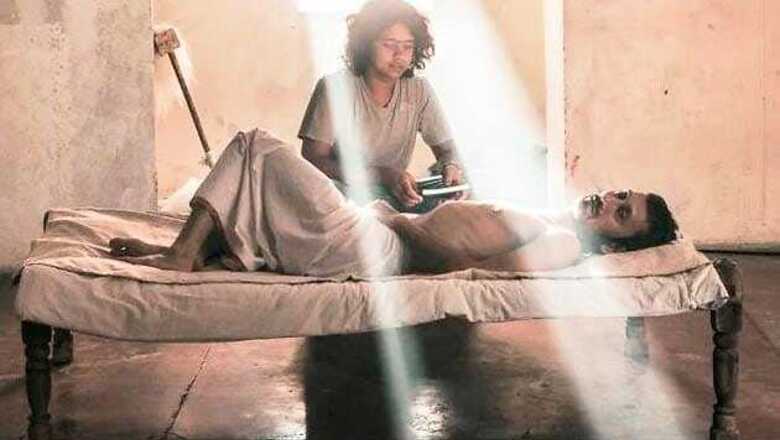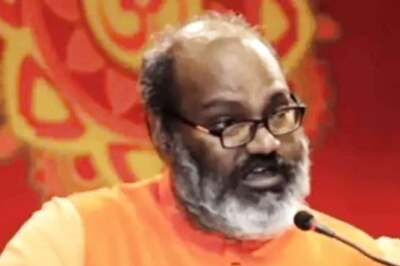
views
The philosophical thesis of 'Mereological essentialism' relates the 'whole' with its 'parts' and the condition of persistence of the state. In essence, if an object as a 'whole' loses or gains a 'part' (or 'parts'), it essentially is 'changed'. This is in line with the famous statement of Heraclitus - "You Cannot Step in the Same River Twice" since both the man and the river change. In essence what these theories try to address are the questions on the process of change and of identity and more importantly acknowledging that 'change' is actually 'static'.
However, these theories and philosophies are subjects that one can choose to ignore and yet live their life in practice and theory. Any representation of life in art needs to draw as much from practice as from theory. Otherwise it remains primarily a philosophical journey devoid of social and physical semblance and sensibility in the life we lead and / or wish to traverse. Hence 'Ship of Theseus' - the paradox about interchanging 'parts' onto a 'whole' leading to the question on interchangeability of identity is one which is a primarily an academic debate rather than a practical physical entity. Anand Gandhi's powerfully crafted film Ship of Theseus (hence forth referred as SOT) raises some questions - on identity, interchange and most importantly about 'change'.
Narrative of SOT
Reportedly, Anand Gandhi defined his film and said-"The three short stories evolved to fill in the three corners of the classical Indian trinity of Satyam-Shivam-Sundaram (The pursuit of truth, the pursuit of righteousness and the pursuit of beauty)." SOT has three inter-woven stories which mesh into a collective 'whole' in the end. The film opens with Egyptian visual artist Aliya with a cornea infection. She takes up photography to change her creative output but maintaining the gush internal to her. She stays in Mumbai with her boyfriend and waiting for an eye treatment which returns her eyesight. Does she remain the same person as before since with her new-found vision she seemed visibly upset that her magic eye was lost in the process? The end of this snippet finds Aliya waiting in calm stupor in front of the magnificence of nature as she lets go the cover of her lens - an awakening?
The second of the trinity finds the monk Maitreya fighting a lawsuit against pharmaceutical companies testing their products on animals. Maitreya is lovable- he is intelligent, often Intellectual yet down-to-earth. He preaches his ideals and follows them in his life and more importantly he accepts the staggering differences amongst individuals. He is treated with an ailment which needs a transplant and he refuses treatment since to him that defeats the cause which he stands by in his life. A young lawyer Charbak, who idolizes Maitreya but follows a different path of reasoning, tries hard to convince Maitreya who waits to embrace death. The exchanges are like Aristotelian debate where Maitreya plays the mature philosopher to Charbak's questions on life, existence and identity - in isolation and in totality. Finally,Maitreya, relents and agrees for a transplant.
The final and more eventful last part finds stock broker Navin who is in constant tussle with his idealist grand-mother who rubbishes Navin as greedy and banishes the generation as irresponsible. Navin goes through kidney replacement and during one of his visits to the nursing home where his grand-mother is admitted, he comes across a poor, impoverished man whose kidney was illicitly removed during a normal appendix operation. Navin takes this as his personal responsibility and tracks down the kidney recipient in Sweden. Eager to close the circle of actions he arranges the Swedish donor to pay for a kidney transplant on the poor man only to find that the latter has amicably settled with the Swedish in exchange of a hefty amount.
The film takes into account different ways of approaching it. The first story of Aliya for example, in line with her hobby, takes up the handheld camera as the medium to reflect on her life and art almost in a self-reflexive way. In spite of the arresting visuals and the grand narratives there are questions on the philosophical aspirations of the theories garlanded in this part as well - if there is a question on her identity (changed or otherwise) after she got back vision, what happens to the same when she lost it in the first place? Was her identity changed then as well? It may well be so, and if that is the case aren't we talking more about Mereology than the Theseus paradox? And then going by the essentialism theory we agree the necessity of change and the mandate it brings - what the big fuss then, or is it to have a pretense - and that too of being 'philosophical'? Maitreya's story for instance is unfortunately obsessed with articulating concepts at the guise of being overtly philosophical and laden with laboured dialogues leaving general audience like me confused and at times, agitated. Understood, that logical linearity is not what we should look for but we still need to yearn for cohesion and correlation. The problem is with how much concession one must provide considering this is an indie film by a debutant film-maker. The greatest analogy from cricket that comes to mind is the fact that a sixteen-something Sachin Tendulkar faced a Wasim Akram in the former's first tour of Pakistan, and, Akram didn't bowl at him slow since Sachin was still almost a 'kid'! If the rule is one for commercial pot-boilers, it has to be similar, if not the same, for any indie film as well.
Allegory of the Cave
Pauline Kael once remarked in The New Yorker -"One's movie-going tastes and habits change-I still like in movies what I always liked but now,for example, I really want documentaries. After all the years of stale-stupid acted-out stories, with less and less for me in them, I am desperate to know something, desperate for facts, for information, for faces of non-actors and for knowledge of how people live-for revelations, not for the little bits of show-business detail worked up for us by show-business minds who got them from the same movies we're tired of." Not only Kael alone, this is the yearning of a section of the Indian audience as well which being lambasted with the popular Bollywood or regional potboilers look out for something which gives them some food for thought. Gandhi for one is intelligent enough to realize - "There is a set of people that has been engaging with world cinema, because of film festivals, retrospectives and the internet, and know that this kind of introspective film is what they're starving for, and crave similar content from India. Even if we're only talking about 2% of the total population, that's about a crore (10million) people! Then, there is the potential audience that has not been groomed to this kind of cinema. They may not immediately fall in love with it when they watch it, but they will see that this is the kind of cinema that they want to engage with." The recent surge of indie films in India thrive on that small percentage which actually becomes not so insignificant if considered in absolute terms. However to reach out to this 2% there are two modes of advertising the product - first, to brand it as different from the mainstream and secondly, to have a brand-ambassador (who also represents the face of alternate cinema) to present and promote the film. Even regional indie films are now being 'presented' by film-makers of repute.
Kiran Rao, who has 'presented' SOT was articulate enough to comment "It's not a film that can take a wide audience. Everybody can't walk in and watch this film because they are not prepared for this kind of cinema, and then they might be disappointed." Cleverly put, the philosopher in you will stir her feathers in order to strive for being a tad different - to accept the film and in turn bask in collective vanity.
SOT ends with a small video clipping showing the man who donated the organs to the protagonists as shooting the interiors of a cave. The shadow of the man with the camera in his hand falls on the crystalline rock and immediately Plato's Allegory of the cave comes to mind - the attempt to explain the philosopher's place in society, to attempt to enlighten the 'prisoners'. If we can replace 'philosopher' with the 'critic' the picture becomes complete.
Traditionally the role and place of the critic in society has been revered and defiled at the same time. But there had never been any denying of the importance of the critic in the social milieu in the practice of culture theory. Like any true art form, the role of a critique was also to foster dialogue and engage in debate - it was not about passing judgments without being accountable to the art in discussion. The role of the critic hence, was not trying to push the readers to the cinema halls for buying tickets, rather she should engage them to find the areas of disagreement, to analyse them and if it seemed a worthy visit, explore the same by viewing the film in question. With the explosion of data in the social media space there has been a conscious effort to make the consumer influential enough to share her thoughts and voice her opinion. The information out of this enormous data (termed as Big Data) is used in analytics for better understanding the consumer preferences as well as in determining market trends. IBM's leading Social Sentiment Index which spurns millions of Tweets to derive positive or negative sentiments on a particular film is one such analytics that is creating a revolution. Professor Jonathan Taplin, Director of the USC Annenberg Innovation Lab commented - "In the past, box office receipts indicated success or failure. Thanks to advances in analytics, movie makers now have the ability to analyze the public sentiments of their viewers in real time. With technologies such as the Film Forecaster, movie studios such as Lionsgate can go beyond receipts, to truly understand the voice of the crowd." Interestingly the sentiment of the crowd is something which snowballs on itself to dictate a trend - you read several tweets, look up the positive and negative sentiment markers and decide on watching the film or not. Technology is precisely taking over the role of the armchair critic whose views were to be waited for and consumed with much fervor. The crowd has the power now and the money - to produce a film and also to extrapolate it to be a hit or a miss in an informed way.
So where will the critic go? The critic will still remain at least for some more time. But like an aged cricketer, he will enjoy his stance now - the burden of destining a piece of art to its proper future squarely rests on the new kid in the block - the New Media. The critic will persist to represent the old world, the world of the written words, of romantic misgivings and veracious thoughts. The images of Maitreya walking boldly through a field intersected by windmills or the caterpillar walking through a sea of human feet or Aliya groping on a wall to feel the texture will hang like a mélange of sensory perceptions which written words fail to attain. The critic, like the dead man in SOT will probably stand in muted wait within the cave - wait till the final words are crunched into a series of binary numbers.




















Comments
0 comment